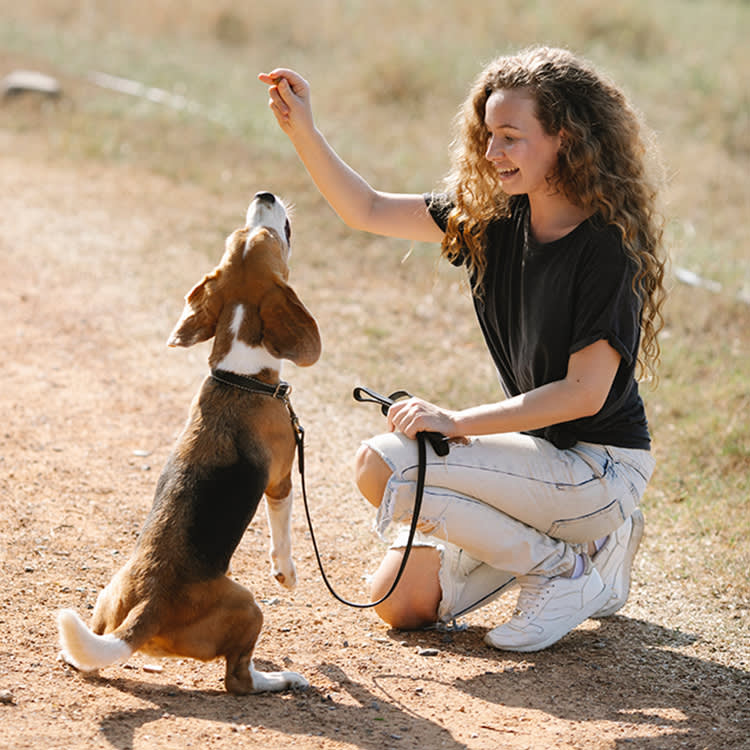Your Dog’s Trauma Triggers Are Everywhere. Fear-Free Training Can Help
“America’s Veterinarian” and the founder of Fear Free Pets, Dr. Marty Becker, on how this method makes vet visits, training sessions, and grooming appointments less stressful for pets.
It all started for Dr. Marty Beckeropens in new tab in 1963: That was the year his family’s outdoor Labrador Retriever came inside the house.
Dr. Becker grew up on a small family farm that raised potatoes and other crops, in addition to cows, sheep, and pigs. Dogs served a utilitarian role on the farm — they herded cattle and guarded the property among other duties. But when a blizzard swept through in 1963, a young Dr. Becker successfully convinced his father to let their outdoor dog spend the night inside. He never left.
In the decades since, Dr. Becker has made a name for himself as “America’s Veterinarianopens in new tab”; he was the resident veterinary contributor on Good Morning America for 17 years, is the author of 23 booksopens in new tab, and is also the founder of Fear Freeopens in new tab, which provides online education to veterinary and pet professionals, animal welfare communities, and pet owners. Kinship recently sat down with Dr. Becker to ask him about what Fear Free actually means — and why modern-day pet parents, whose pets are their children, are embracing the method.
This interview has been edited for length and clarity.
How much do you spend on your pet per year?
Let’s start with the basics: What exactly is Fear-Free training?
It boils down to looking at [a pet’s] physical and emotional well-being. Before Fear Free, the focus was always on physical wellbeing. Most of my colleagues and I thought that fear, anxiety, and stress were collateral damage — that there was nothing you could do. You could still be compassionate, you could still look at pain, but you just had to accept that [a pet] hated going to the veterinarian or trainer or groomer.
Fear-Free training is positive reward-based training. Part of our slogan is to “put the treat into treatment.” You show [a pet] what you want them to do and then reward them when they do it, or get close to doing it. Fear Free always works to reduce or remove triggers that cause fear, anxiety, and stress.
How does it work?
If I were a therapist, I could ask you all sorts of things that happened in your life that were traumatic and you could ferret them out and we could decide we’re going to avoid this, or you’re going to deal with it this way. With a pet, you have no idea what happened to them. Were they attacked by another dog when they were younger? Did something negative happen to them on a walk? Were they dragged out of a cage at a veterinary hospital?
[Fear-Free training involves] the pet parent on the front end of visiting a veterinarian, groomer, or trainer. A pet parent can’t bring in a pet that’s really agitated and throwing up from stress and think it’s going to be a good visit. [Fear-Free training] starts in the living room. If a pet is going to be in a carrier, [the pet parent] got it out a week before, not the night before or the morning of. High-value rewards are given there so there are positive associations with the carrier. In transport, you keep the car at the same temperature as the house. If you’re going to a trainer, it’s the same temperature there. If the dog is in the carrier, you make sure the carrier is not tipped and covered on three sides by a light sheet to reduce visual stimuli.
Fear Free is a science-based organization. There’s over 300 studies it’s based on. We fund a decent amount of research for the size or our company. We know, for example, that pets in transport like fleece better than towels. They like pastel colors and c ertain types of music. It’s how pets are introduced to a facility. If somebody comes to your house or if you go to a groomer, if the pet is greeted outside in what is neutral territory, it makes a big difference, as opposed to going inside the facility, because then they’re not territorial.
[Humans] are primarily verbal communicators and [pets are] primarily body- language communicators. Once you understand [your pet’s] body language, you almost crack the code on a different level of understanding and appreciating your dog. You get to where you’re detecting the most subtle changes early on before it erupts into something worse.
For years, you practiced veterinary medicine, have written 23 books, and worked in the media. What led you to start Fear-Free Training?
I was at a conference in 2009, and Dr. Karen Overall opens in new tab gave the keynote. Her talk changed my life. Her first sentence was, “Fear is the worst thing a social species can experience, and it causes permanent damage to the brain.” Second sentence: “Those of us in veterinary medicine, training, grooming, animal services are causing repeat, severe psychological damage to pets by what we are doing or not doing.” She continued: “Behavior produces a physiologic response so behavior is medicine. Fear is caused by something painful or something disturbing.”
She gave some great examples. You trim a dog’s nails too short. Now when they see the nail trimmer, or even the place where you trim them or the drawer that they’re held in — that’s disturbing.
The thing that really got me: All pets are the equivalent of a 1-year-old child. There are four reasons. One, they’re taken against their will for healthcare. Two, they have zero idea why a procedure benefits them. Three, they have no concept of time. And lastly, they have no control — they can’t flee the threat. That’s the important part; we have control over stuff that they don’t.
You offer Fear Free Certification Programsopens in new tab for veterinarians, shelters, pet parents, and other pet professionals. Why did you create distinct approaches to Fear-Free training for each of these different groups?
We figured out how to do [Fear-Free training] in the veterinary hospital, in probably the worst setting. If we could remove or reduce the triggers — we call it “taking the pet out of petrified” — in that setting, we figured you could probably do it in other settings. And we thought, what good is it to have a phenomenal visit to the veterinarian when [a pet is] suffering from anxiety and stress at home?
So, we’ve [created certificates for] training, grooming, pet sitting, boarding, and daycare, dog walking is coming up. Everybody that has contact with a pet [should look] at both its physical and emotional well-being.
What are some of the worst or most common misconceptions out there that Fear-Free training dispels?
Probably the biggest thing is that pets don’t have emotions like we do. You can’t anthropomorphize pets too much, but pets definitely have feelings. When your dog looks at you, that is the look of love. That is unmistakable; it melts you. I don’t think a human can do the same thing — it doesn’t look the same. So yes they love, yes they have fear, have anxiety, have loneliness. They have all these same things.
The other thing is that every single day your dog is being trained. Something happens that changes [the pet’s] behavior every day, so you have to be careful that you’re always working so the pet has the kind of manners that fit in with the happy home.
Do you have advice for how pet parents can find fear-free professionals (trainers, groomers, and vets)?
Fear Free Happy Homesopens in new tab is complementary to all pet parents. There’s no login or barriers. Everything we have is reviewed by [a] boarded veterinary behaviorist. That’s one of the things we’re really proud of. It’s authentic information.
Are there any clear red flags pet owners should be aware of if they’re already working with individuals who they aren’t sure are Fear Free?
The worst thing for a pet parent is to feel like you’re hurting your pet by trying to help them. If your pet thinks it will absolutely be harmed or is going to die when it goes to the veterinarian, that’s a red flag. If the vet insists on putting your pet up on the table every time, that’s a red flag. If they’re handling them roughly or restraining them, that’s a red flag.
What [Fear Free does] is gentle control. You still get the same thing — positional compliance — but it’s designed to protect the pet. Restraint is designed to protect people. So your pet should be more cooperative in its care — they’re not showing extreme distress, they’re taking treats. You can tell if your vet has an affection for your pet and isn’t treating it like an inanimate object.
And trainers — anyone that is using prong collars or shock collars or any kind of aversive training.
There’s a ton of information out there about pet parenting. Why should pet parents specifically pay attention to Fear-Free training?
If you love your pet like family, I would want you to have the same level of science and soul that you would have for a human child or grandchild or nephew or niece — that physical and emotional wellbeing are important. Fear Free is where high tech meets high touch, where state of the art meets state of the heart. Yeah, we’ve got the science behind it, the studies behind it, but more than that, we love pets like family and we want to see them live happy, healthy, full lives.













